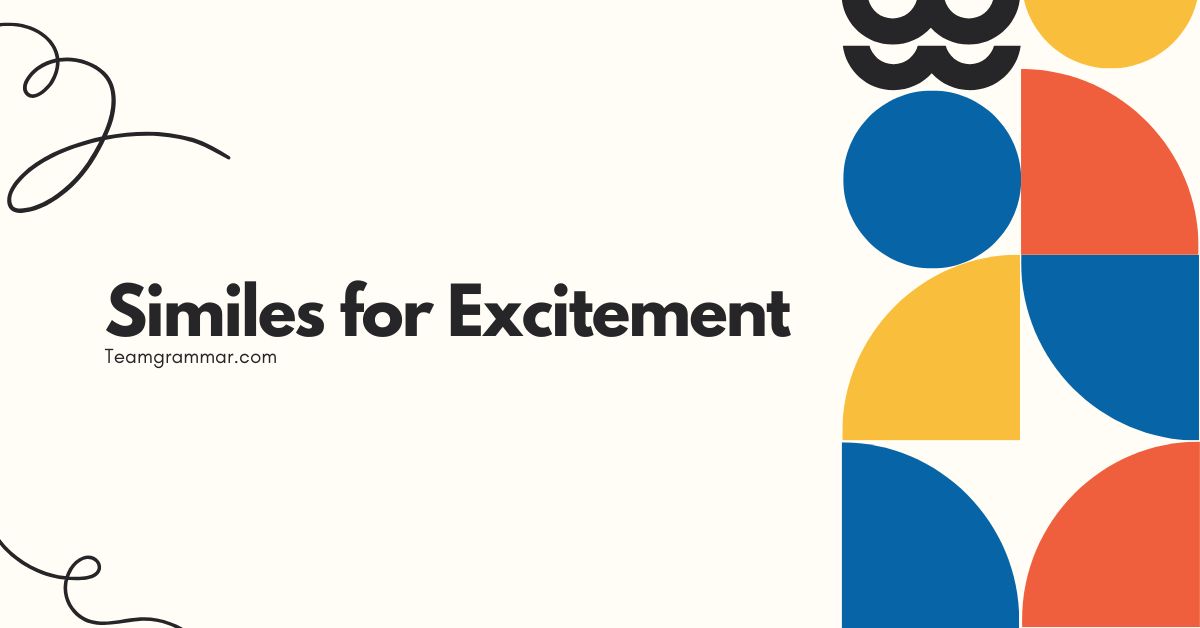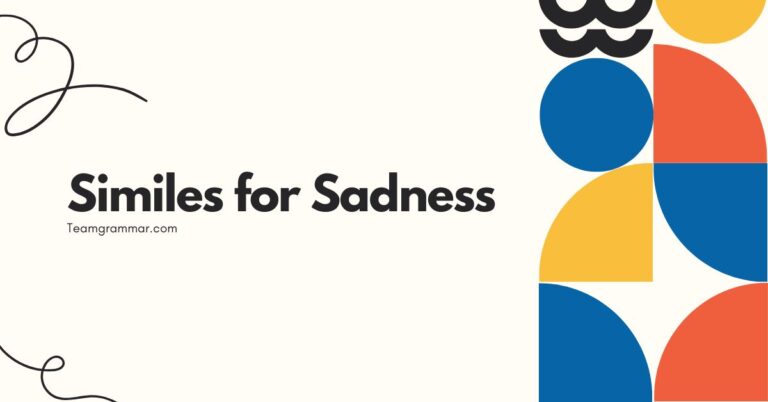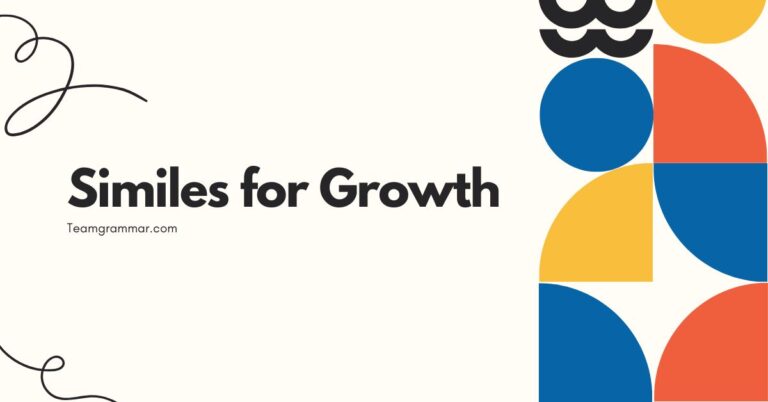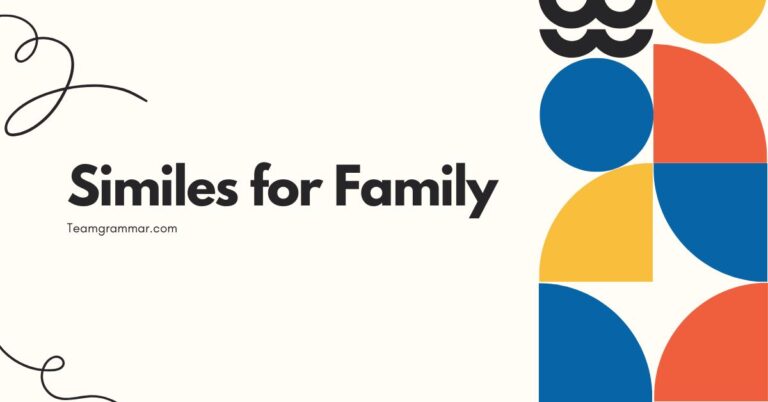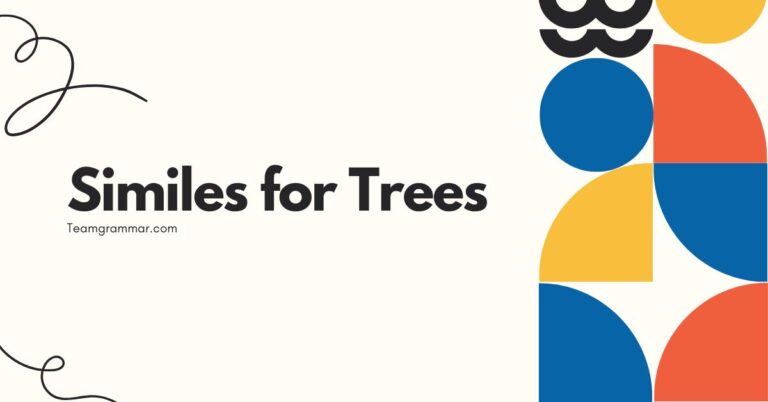39 Similes for Excitement: Mastering Figurative Language
Understanding similes is crucial for enhancing your writing and communication skills. Similes, which compare two unlike things using “like” or “as,” add vividness and depth to descriptions, especially when conveying emotions such as excitement.
This article delves into the world of similes for excitement, providing definitions, structural breakdowns, examples, usage rules, and practice exercises. Whether you’re a student, writer, or English language learner, this guide will equip you with the knowledge to use similes effectively and creatively, making your expressions more engaging and impactful.
Table of Contents
- Introduction
- Definition of Simile
- Structural Breakdown of Similes
- Types of Similes
- Examples of Similes for Excitement
- Usage Rules for Similes
- Common Mistakes with Similes
- Practice Exercises
- Advanced Topics in Similes
- Frequently Asked Questions
- Conclusion
Definition of Simile
Asimileis a figure of speech that compares two unlike things using the words “like” or “as.” This comparison aims to create a vivid image or emphasize a particular quality. Similes are essential tools in descriptive writing and everyday conversation, allowing speakers and writers to convey emotions, ideas, and sensory experiences more effectively.
They differ from metaphors, which directly state that one thing *is* another, rather than suggesting a similarity.
The primary function of a simile is to enhance understanding and create a more engaging experience for the reader or listener. By drawing a parallel between something familiar and something less known, similes can clarify complex ideas and make them more relatable.
Similes are also used to evoke emotions, add humor, and create a sense of imagery in various contexts, including literature, poetry, and everyday speech.
Classification of Similes
Similes can be classified based on their function and the type of comparison they make. For example, some similes focus on physical attributes, while others emphasize emotional states or abstract concepts.
Understanding these classifications can help writers and speakers choose the most appropriate simile for their specific purpose.
Function of Similes
The function of a simile extends beyond mere comparison. It serves to provide clarity, add emphasis, and create imagery.
A well-crafted simile can transform a mundane description into something memorable and impactful. The power of a simile lies in its ability to connect disparate ideas in a meaningful way, enriching the overall communication.
Contexts for Using Similes
Similes are versatile and can be used in a wide range of contexts. They are commonly found in literature, poetry, advertising, and everyday conversation.
In literature, similes are used to enhance descriptions and develop themes. In advertising, they are used to make products more appealing and memorable.
In everyday conversation, similes can add humor and expressiveness to communication.
Structural Breakdown of Similes
A simile typically consists of three main components: thesubject, thelinking word(“like” or “as”), and thebasis of comparison. The subject is the thing being described, the linking word establishes the comparison, and the basis of comparison highlights the shared quality between the subject and the thing it is being compared to.
Understanding these components is essential for constructing effective and meaningful similes.
The general pattern for a simile is: Subject + Linking Word (like/as) + Basis of Comparison. For example, in the simile “He was as fast as a cheetah,” “He” is the subject, “as” is the linking word, and “a cheetah” is the basis of comparison, emphasizing the subject’s speed.
The strength of a simile depends on the clarity and relevance of the comparison. A well-chosen simile can significantly enhance the impact of a sentence or passage.
The Subject
The subject of a simile is the element being described or compared. It can be a person, object, idea, or emotion.
The subject sets the context for the comparison and provides the focus for the simile. Choosing a relevant and appropriate subject is crucial for the simile to be effective.
The Linking Word
The linking word, typically “like” or “as,” establishes the connection between the subject and the basis of comparison. While “like” and “as” are the most common linking words, other words such as “than” can also be used, although less frequently.
The linking word signals that a comparison is being made and sets the stage for the reader or listener to understand the relationship between the two elements.
The Basis of Comparison
The basis of comparison is the shared quality or characteristic between the subject and the thing it is being compared to. This is the key element that makes the simile meaningful and effective.
The basis of comparison should be clear and relevant to the subject, highlighting a specific attribute or quality that the two elements share. A strong basis of comparison creates a vivid and memorable image in the mind of the reader or listener.
Types of Similes
Similes can be categorized based on the type of comparison they make and the effect they create. Some common types of similes include descriptive similes, emotional similes, and hyperbolic similes.
Each type serves a different purpose and can be used to enhance different aspects of writing and communication. Understanding these types can help you choose the most appropriate simile for your intended effect.
Descriptive Similes
Descriptive similes focus on physical attributes or characteristics. They are used to create a vivid image of the subject by comparing it to something with similar qualities.
These similes often appeal to the senses, providing a clear and detailed picture in the reader’s mind. Descriptive similes are particularly useful in setting the scene and creating a sense of realism.
Emotional Similes
Emotional similes convey feelings and emotions by comparing them to relatable experiences or objects. These similes help the reader understand the intensity and nature of the emotion being described.
Emotional similes can be powerful tools for creating empathy and connecting with the reader on a deeper level. They are often used to express complex or abstract emotions in a more accessible way.
Hyperbolic Similes
Hyperbolic similes use exaggeration to emphasize a particular quality or characteristic. These similes are not meant to be taken literally but are used to create a strong impression and add humor or emphasis.
Hyperbolic similes can be particularly effective in creating a memorable and impactful statement. They are often used to express extreme emotions or to highlight a particular aspect of the subject.
Examples of Similes for Excitement
Similes are a fantastic way to express excitement, adding color and depth to your descriptions. Below are several examples of similes that capture the feeling of excitement, categorized for clarity.
General Excitement Similes
These similes capture general feelings of excitement and anticipation.
The following table presents examples of similes for general excitement. Each example illustrates how to effectively convey feelings of eagerness and anticipation using figurative language.
| Simile | Explanation |
|---|---|
| He was as excited as a kid on Christmas morning. | Captures the pure joy and anticipation of a child. |
| She felt like she had won the lottery. | Expresses overwhelming happiness and disbelief. |
| They were as thrilled as if they’d climbed Mount Everest. | Conveys a sense of accomplishment and exhilaration. |
| His heart raced like a hummingbird’s wings. | Illustrates the physical sensation of excitement. |
| She bounced around like a rubber ball. | Depicts the energetic and restless nature of excitement. |
| He was as eager as a puppy waiting for a treat. | Shows innocent anticipation and desire. |
| She felt like she was floating on air. | Expresses a light, euphoric feeling. |
| They cheered as if their team had won the championship. | Conveys intense enthusiasm and support. |
| His eyes sparkled like diamonds. | Illustrates the visible joy and excitement. |
| She trembled with excitement like a leaf in the wind. | Shows a delicate, almost nervous anticipation. |
| He grinned like a Cheshire cat. | Depicts a wide, satisfied smile. |
| She felt like she was about to burst with joy. | Expresses an overwhelming feeling of happiness. |
| They were as giddy as school children on the last day of class. | Conveys carefree and unrestrained excitement. |
| His pulse quickened like a drumbeat. | Illustrates the physical manifestation of excitement. |
| She jumped for joy like she had springs in her shoes. | Depicts energetic and unrestrained happiness. |
| He was as animated as a cartoon character. | Shows lively and expressive enthusiasm. |
| She felt like she was dreaming with her eyes open. | Expresses a surreal and blissful feeling. |
| They celebrated like they had discovered gold. | Conveys a sense of great fortune and accomplishment. |
| He was as jumpy as a frog on a hot plate. | Depicts restlessness and an inability to stay still. |
| She felt like she was on top of the world. | Expresses a sense of invincibility and joy. |
| They were as happy as clams at high tide. | Conveys a state of complete contentment and joy. |
| His face lit up like a Christmas tree. | Shows radiant happiness and excitement. |
| She felt like she could fly. | Expresses a feeling of freedom and exhilaration. |
| They were as keyed up as racehorses before a race. | Depicts intense anticipation and readiness. |
| His laughter bubbled up like a spring. | Illustrates spontaneous and joyful laughter. |
| She felt like she had won the golden ticket. | Expresses a sense of extraordinary luck and opportunity. |
Similes for Anticipation
These similes focus on the feeling of looking forward to something exciting.
The following table provides similes specifically tailored to express the feeling of anticipation. These examples help illustrate the build-up of excitement before an event or experience.
| Simile | Explanation |
|---|---|
| He waited with anticipation like a child waiting for Santa. | Captures the eager and hopeful expectation. |
| She felt the anticipation building like a crescendo. | Expresses the gradual increase in excitement. |
| They were as expectant as an audience before a play. | Conveys a sense of poised readiness and excitement. |
| His excitement mounted like a roller coaster climbing a hill. | Illustrates the building tension and anticipation. |
| She felt like she was on the verge of a great adventure. | Depicts a sense of imminent excitement and possibility. |
| He was as ready as a coiled spring. | Shows pent-up energy and anticipation. |
| She felt like she was holding her breath. | Expresses a tense and expectant feeling. |
| They were as nervous as actors before opening night. | Conveys a mix of excitement and anxiety. |
| His anticipation was as palpable as a physical presence. | Illustrates a strong and noticeable feeling of excitement. |
| She felt like she was counting down the seconds. | Shows an eagerness for time to pass quickly. |
| He waited like a predator stalking its prey. | Depicts focused and intense anticipation. |
| She felt the excitement bubbling like a simmering pot. | Expresses a restrained yet building anticipation. |
| They were as keyed up as athletes before a competition. | Conveys a state of readiness and heightened energy. |
| His anticipation crackled like electricity in the air. | Illustrates a vibrant and energetic feeling of excitement. |
| She felt like she was standing on the edge of a cliff. | Depicts a sense of thrilling uncertainty. |
| He was as eager as a student awaiting exam results. | Shows anxious yet hopeful anticipation. |
| She felt like she was on the cusp of something amazing. | Expresses a sense of imminent opportunity. |
| They were as excited as children on a field trip. | Conveys innocent and unrestrained anticipation. |
| His anticipation grew like a balloon being inflated. | Illustrates the gradual increase in excitement. |
| She felt like she was about to embark on a journey. | Depicts a sense of new beginnings and possibilities. |
| They were as impatient as travelers waiting for a delayed flight. | Conveys restless and eager anticipation. |
| His excitement shimmered like heat waves on a summer road. | Shows a vibrant and almost tangible anticipation. |
| She felt like she was unwrapping a present. | Expresses a sense of curiosity and excitement. |
| They were as watchful as owls waiting for nightfall. | Depicts focused and patient anticipation. |
Similes for Joyful Excitement
These similes specifically convey the joyful aspect of excitement.
The following table focuses on similes that express joyful excitement. These examples highlight the happiness and delight associated with exciting experiences.
| Simile | Explanation |
|---|---|
| He laughed with joy like bells ringing. | Captures the clear and bright sound of happiness. |
| She smiled with joy like the sun rising. | Expresses radiant and warm happiness. |
| They celebrated with joy like birds singing in spring. | Conveys a lively and natural expression of happiness. |
| His heart overflowed with joy like a river bursting its banks. | Illustrates an overwhelming feeling of happiness. |
| She felt joy bubbling inside her like champagne. | Depicts a sparkling and effervescent feeling of happiness. |
| He was as happy as a lark. | Shows lighthearted and carefree joy. |
| She felt like she was dancing on clouds. | Expresses a feeling of lightness and joy. |
| They rejoiced with joy like children playing in the park. | Conveys innocent and unrestrained happiness. |
| His eyes shone with joy like stars in the night sky. | Illustrates a bright and radiant expression of joy. |
| She felt joy spreading through her like sunshine. | Expresses a warm and comforting feeling of happiness. |
| He sang with joy like a nightingale. | Depicts pure and melodious happiness. |
| She felt like she had found a treasure. | Expresses a sense of great fortune and joy. |
| They laughed with joy like tickled babies. | Conveys pure and infectious happiness. |
| His joy radiated like a beacon. | Illustrates a bright and noticeable feeling of happiness. |
| She felt like she was floating in a sea of happiness. | Expresses an immersive and overwhelming feeling of joy. |
| He was as content as a cat in a sunbeam. | Shows peaceful and serene joy. |
| She felt like she had reached the summit of a mountain. | Expresses a sense of accomplishment and joy. |
| They danced with joy like puppets on strings. | Conveys carefree and unrestrained happiness. |
| His joy sparkled like fireworks. | Illustrates a vibrant and celebratory feeling of happiness. |
| She felt like she was wrapped in a warm embrace. | Expresses a comforting and secure feeling of joy. |
Usage Rules for Similes
Using similes effectively requires adherence to certain rules. First, ensure that the comparison is clear and relevant.
The two things being compared should share a recognizable quality. Second, avoid clichés.
Overused similes lose their impact and can make your writing seem unoriginal. Third, be mindful of the context.
The simile should fit the tone and style of your writing. Finally, ensure that the simile enhances rather than distracts from your message.
The key to using similes well is to be creative and thoughtful. Experiment with different comparisons and consider the effect you want to create.
A well-crafted simile can add depth and richness to your writing, making it more engaging and memorable. However, a poorly chosen simile can be confusing or distracting, so it’s important to use them judiciously.
Relevance of Comparison
The comparison made in a simile should be relevant and logical. The shared quality between the subject and the object of comparison should be clear and easily understood.
An irrelevant or nonsensical comparison can confuse the reader and detract from the overall message.
Avoiding Clichés
Clichés are overused expressions that have lost their impact. Avoid using common similes such as “as busy as a bee” or “as quiet as a mouse.” Instead, strive to create original and fresh comparisons that will capture the reader’s attention and add a unique flavor to your writing.
Contextual Appropriateness
The simile should be appropriate for the context and tone of your writing. A simile that is too informal or humorous may not be suitable for a serious or formal piece.
Consider the overall message and choose similes that enhance and complement it.
Common Mistakes with Similes
One common mistake is using similes that are too obvious or cliché. For example, saying someone is “as strong as an ox” is not very original.
Another mistake is using similes that don’t make sense or create a confusing image. For instance, “He was as loud as a whisper” is contradictory.
Finally, some writers overuse similes, which can make their writing seem forced and unnatural.
To avoid these mistakes, focus on creating fresh and meaningful comparisons. Think about the specific quality you want to emphasize and choose a comparison that vividly illustrates that quality.
Also, be mindful of the overall tone and style of your writing. Use similes sparingly and only when they truly enhance your message.
Obvious or Cliché Similes
Using overused similes can make your writing seem unoriginal and uninspired. Strive to create fresh and unique comparisons that will capture the reader’s attention and add a distinctive voice to your writing.
Avoid relying on tired expressions that have lost their impact.
Illogical or Confusing Similes
A simile should create a clear and logical comparison. Avoid using similes that are contradictory or nonsensical, as they can confuse the reader and detract from the overall message.
Ensure that the comparison is meaningful and easy to understand.
Overusing Similes
Using too many similes can make your writing seem forced and unnatural. Similes should be used sparingly and only when they truly enhance your message.
Focus on quality over quantity and choose similes that have a significant impact.
Practice Exercises
Test your understanding of similes with the following exercises. Identify the similes in each sentence and explain their meaning.
Then, create your own similes to describe the given scenarios. These exercises will help you practice using similes effectively and creatively.
Exercise 1: Identifying Similes
In this exercise, identify the similes used in the following sentences.
| Question | Answer |
|---|---|
| 1. The music was as soothing as a gentle breeze. | Simile: “as soothing as a gentle breeze.” Meaning: The music was very calming and relaxing. |
| 2. He ran as fast as a cheetah. | Simile: “as fast as a cheetah.” Meaning: He ran very quickly. |
| 3. Her smile was like sunshine on a cloudy day. | Simile: “like sunshine on a cloudy day.” Meaning: Her smile was bright and uplifting. |
| 4. The news hit him like a ton of bricks. | Simile: “like a ton of bricks.” Meaning: The news was shocking and overwhelming. |
| 5. She was as quiet as a mouse. | Simile: “as quiet as a mouse.” Meaning: She was very quiet. |
| 6. The cake was as light as a feather. | Simile: “as light as a feather.” Meaning: The cake was very airy and delicate. |
| 7. He slept like a log. | Simile: “like a log.” Meaning: He slept very soundly. |
| 8. The rain fell like tears from the sky. | Simile: “like tears from the sky.” Meaning: The rain was heavy and sorrowful. |
| 9. She was as graceful as a swan. | Simile: “as graceful as a swan.” Meaning: She moved with elegance and poise. |
| 10. The idea spread like wildfire. | Simile: “like wildfire.” Meaning: The idea spread very quickly and widely. |
Exercise 2: Creating Similes
For each of the following scenarios, create a simile to describe the situation.
| Scenario | Simile |
|---|---|
| 1. Describe the feeling of being very tired. | Answer: I felt as tired as a marathon runner at the finish line. |
| 2. Describe a very hot day. | Answer: The sun was as scorching as a furnace. |
| 3. Describe a loud noise. | Answer: The explosion was like a thunderclap. |
| 4. Describe a beautiful sunset. | Answer: The sunset was as colorful as a painter’s palette. |
| 5. Describe a difficult task. | Answer: The task was as challenging as climbing a mountain. |
| 6. Describe a peaceful scene. | Answer: The lake was as still as a mirror. |
| 7. Describe a crowded room. | Answer: The room was as packed as a can of sardines. |
| 8. Describe a delicious meal. | Answer: The meal was as delightful as a taste of heaven. |
| 9. Describe a scary movie. | Answer: The movie was as frightening as a nightmare. |
| 10. Describe a fast car. | Answer: The car was as swift as a rocket. |
Advanced Topics in Similes
For advanced learners, exploring more nuanced aspects of similes can further refine their understanding and usage. This includes understanding the interplay between similes and metaphors, recognizing cultural variations in simile usage, and mastering the art of creating subtle and sophisticated comparisons.
Similes vs. Metaphors
Understanding the difference between similes and metaphors is crucial for advanced learners. While both are figures of speech that make comparisons, similes use “like” or “as” to explicitly state the comparison, whereas metaphors imply the comparison without using these words.
Mastering the subtle distinctions between these two literary devices can significantly enhance your writing skills.
Cultural Variations in Similes
Similes can vary significantly across cultures, reflecting different values, beliefs, and experiences. Understanding these cultural variations is important for effective cross-cultural communication.
A simile that is meaningful and impactful in one culture may be confusing or offensive in another. Therefore, it’s essential to be aware of cultural nuances when using similes in a global context.
Creating Subtle and Sophisticated Comparisons
Advanced learners should strive to create similes that are not only clear and relevant but also subtle and sophisticated. This involves choosing comparisons that are less obvious and more thought-provoking.
A well-crafted simile can add depth and complexity to your writing, making it more engaging and memorable. Experiment with different comparisons and consider the overall effect you want to create.
Frequently Asked Questions
- What is the difference between a simile and a metaphor?
A simile uses “like” or “as” to compare two things explicitly, while a metaphor directly states that one thing *is* another. For example, “He is as brave as a lion” (simile) vs. “He is a lion” (metaphor).
- Why are similes important in writing?
Similes add vividness, clarity, and engagement to your writing. They help readers visualize and understand concepts by drawing comparisons to familiar things.
- Can a simile be a cliché?
Yes, if a simile is overused, it becomes a cliché. Avoid common expressions like “as busy as a bee” and strive for originality.
- How do I create a good simile?
Choose a comparison that is clear, relevant, and enhances the meaning of your sentence. Avoid clichés and be mindful of the context and tone of your writing.
- What are the key components of a simile?
The key components are the subject, the linking word (“like” or “as”), and the basis of comparison.
- Is it possible to overuse similes?
Yes, using too many similes can make your writing seem forced and unnatural. Use them sparingly and only when they truly enhance your message.
- How do similes differ across cultures?
Similes can vary significantly across cultures, reflecting different values, beliefs, and experiences. Be aware of cultural nuances when using similes in a global context.
- Can similes be used in formal writing?
Yes, similes can be used in formal writing, but they should be used judiciously and should fit the tone and style of the piece. Avoid overly casual or humorous similes in formal contexts.
- What is the role of similes in poetry?
Similes are frequently used in poetry to create vivid imagery, convey emotions, and enhance the overall aesthetic appeal of the poem. They help poets express complex ideas in a concise and impactful way.
- How can I improve my ability to create effective similes?
Practice is key. Read widely, pay attention to how other writers use similes, and experiment with different comparisons. The more you practice, the better you will become at crafting effective and original similes.
Conclusion
Mastering the use of similes, especially when expressing excitement, can significantly enhance your writing and communication skills. This article has provided a comprehensive guide to understanding similes, including their definition, structural breakdown, types, examples, usage rules, and common mistakes.
By understanding these concepts and practicing the exercises provided, you can effectively and creatively use similes to add depth, clarity, and engagement to your writing.
Remember to focus on creating fresh and meaningful comparisons, avoiding clichés, and being mindful of the context and tone of your writing. With practice and attention to detail, you can become proficient in using similes to express emotions, ideas, and sensory experiences in a more vivid and impactful way.
Keep exploring and experimenting with similes to unlock their full potential and elevate your writing to new heights.

